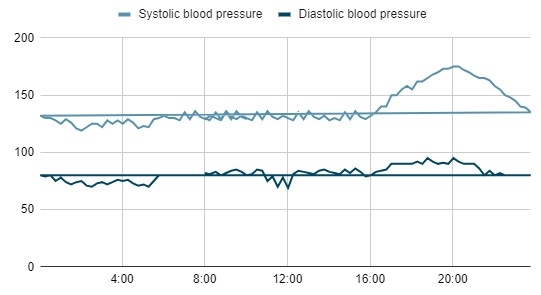Final ID: P-324
Masked Hypertension Mimicking Migraine: A Case Report with Diagnostic Odyssey
Abstract Body: INTRODUCTION: Masked hypertension (MH) involves normal office blood pressure but elevated readings outside clinical settings, increasing cardiovascular and neurological risks. About 10-30% of the population may have MH, often undiagnosed. This case highlights the importance of considering MH.
CASE PRESENTATION: A 42-year-old woman had recurrent headaches for six months: bilateral, pulsating pain in the temples, with dizziness and occasional vomiting, lasting 2-4 hours, worsening after work. Diagnosed with migraines and treated with sumatriptan without relief. Medical history included a caesarean section; otherwise, she was healthy.
Physical exam showed normal vital signs, including blood pressure at 130/80 mmHg. Neurological and ophthalmological evaluations were normal. Lab investigations were unremarkable. The patient had a normal BMI of 21.3. Further workup, including ECG, MRI, CT scan, and neck radiography, all normal.
Ambulatory blood pressure monitoring (ABPM) revealed elevated blood pressure during evening hours (post work), starting around 4 pm and rising until 8-9 pm. Thereafter, blood pressure normalized to 110-130 mmHg systolic and 70-80 mmHg diastolic.
To rule out nephrogenic hypertension, an ultrasound of the kidneys, renal function tests, urinalysis, and plasma metanephrine tests were negative. Following the exclusion of other causes, a diagnosis of MH was established. The patient started on Telmisartan 20 mg daily, with lifestyle modifications. Follow-up ABPM showed normalized blood pressure, and the patient reported no further headaches.
DISCUSSION: MH affects many but often remains undiagnosed due to normal clinic readings. Ambulatory or home blood pressure monitoring is essential for diagnosis. Timely diagnosis of MH is crucial, given its association with heightened risks of stroke and cardiovascular disease. Studies have revealed significantly elevated left ventricular mass index, maximal intima-media thickness, and urinary albumin levels. Consequences include left ventricular hypertrophy, carotid atherosclerosis, and albuminuria.
CONCLUSION: Early recognition and management of MH are vital for preventing complications. Diagnosis can be achieved by home blood pressure monitoring (HBPM) or 24-hour ambulatory blood pressure. This case stresses considering MH in patients with normal office readings but persistent symptoms, advocating for regular monitoring and patient education for optimal health outcomes.
CASE PRESENTATION: A 42-year-old woman had recurrent headaches for six months: bilateral, pulsating pain in the temples, with dizziness and occasional vomiting, lasting 2-4 hours, worsening after work. Diagnosed with migraines and treated with sumatriptan without relief. Medical history included a caesarean section; otherwise, she was healthy.
Physical exam showed normal vital signs, including blood pressure at 130/80 mmHg. Neurological and ophthalmological evaluations were normal. Lab investigations were unremarkable. The patient had a normal BMI of 21.3. Further workup, including ECG, MRI, CT scan, and neck radiography, all normal.
Ambulatory blood pressure monitoring (ABPM) revealed elevated blood pressure during evening hours (post work), starting around 4 pm and rising until 8-9 pm. Thereafter, blood pressure normalized to 110-130 mmHg systolic and 70-80 mmHg diastolic.
To rule out nephrogenic hypertension, an ultrasound of the kidneys, renal function tests, urinalysis, and plasma metanephrine tests were negative. Following the exclusion of other causes, a diagnosis of MH was established. The patient started on Telmisartan 20 mg daily, with lifestyle modifications. Follow-up ABPM showed normalized blood pressure, and the patient reported no further headaches.
DISCUSSION: MH affects many but often remains undiagnosed due to normal clinic readings. Ambulatory or home blood pressure monitoring is essential for diagnosis. Timely diagnosis of MH is crucial, given its association with heightened risks of stroke and cardiovascular disease. Studies have revealed significantly elevated left ventricular mass index, maximal intima-media thickness, and urinary albumin levels. Consequences include left ventricular hypertrophy, carotid atherosclerosis, and albuminuria.
CONCLUSION: Early recognition and management of MH are vital for preventing complications. Diagnosis can be achieved by home blood pressure monitoring (HBPM) or 24-hour ambulatory blood pressure. This case stresses considering MH in patients with normal office readings but persistent symptoms, advocating for regular monitoring and patient education for optimal health outcomes.
More abstracts on this topic:
A Blood(y) Pressure Crisis: Diffuse Alveolar Hemorrhage as a Rare Manifestation of Severely Uncontrolled Hypertension
Nandyal Shreyas, Amdetsion Gedion Yilma, Varma Revati, Kohli Saksham, Hammo Hasan
Disparities in Associations Between Migraine and Cardiovascular Events: A Cross Sectional Cohort Study in the Veterans Health AdministrationSeng Elizabeth, Schwartz Alexandra, Lipton Richard, Ezzti Ali, Sico Jason


